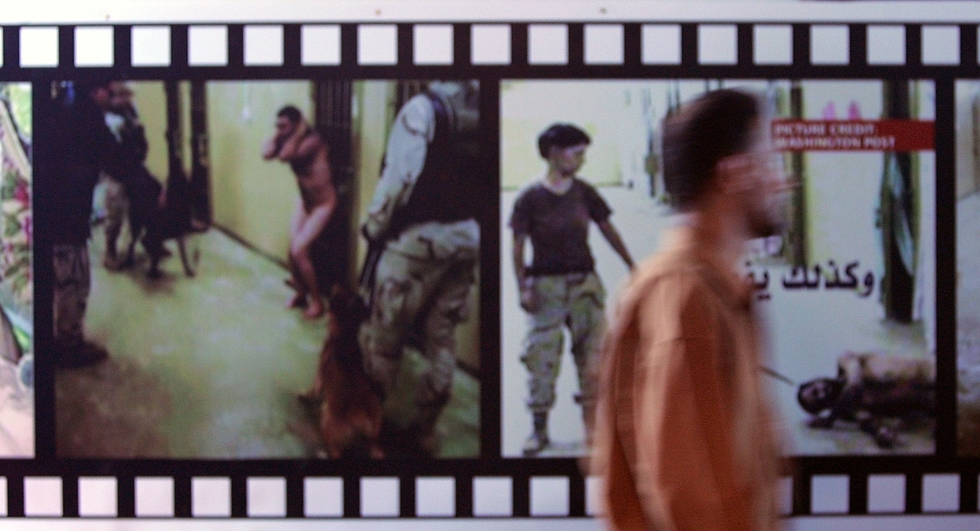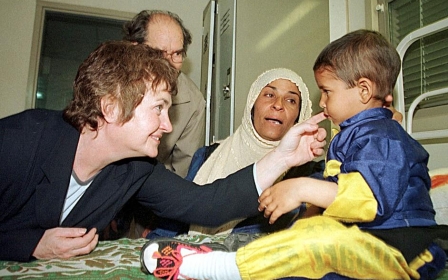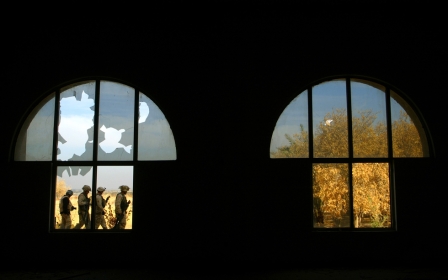The Iraq war was born and raised in torture

The Chilcot report must recognise that Britain went to war in Iraq based on falsified information and tortured confessions.
For those who have seen the use of orange jumpsuits and hoods on prisoners by Islamic State in Iraq, there is little doubt that the legacies of the “war on terror” have travelled beyond the illegality of the war on Iraq. It mirrored not only the abuse that was carried out on detainees around the world by the US, but also that which was specifically used against the leadership of IS while they were in US custody,
The story of torture in relation to Iraq is important and complicated, as it not only justified the war, but permitted an environment where torture was normalised. The DNA of the Iraq war was constructed through a story of torture for which there still has been no accountability.
Now, more than ever, following bombings carried out by IS in Baghdad, Istanbul and Dhaka - and Paris and Brussels before that - there is great need for a thorough examination of why the world is a far less safe place than before the invasion of Iraq.
The long-awaited Chilcot inquiry into Britain's role in the Iraq war should address to what extent the Blair government misled the British people about Saddam Hussain’s chemical weapons capabilities. However, the use of evidence based on torture to justify the war is still being underplayed. This aspect is crucial to understand since not only did it set the stage for the modus operandi of the war, but the perpetrators have still not been held accountable.
A contrived plot
On 5 February 2003, Colin Powell, the former US secretary of state, stood before the United Nations Security Council and presented a case for the invasion of Iraq. He claimed that, “…every statement I make today is backed up by sources, solid sources,” while making the case that there was a “sinister nexus between Iraq and the al-Qaida terrorist network.”
This argument, based on the suggestion of a Europe-wide “ricin plot” planned by Saddam and al-Qaeda, would go on to formulate one of the key cases that would be peddled in the media in order to justify the war.
What was the basis for Powell’s source of this nexus between al-Qaeda and Saddam Hussein’s regime? Ultimately, its roots lay in the invasion of Afghanistan two years earlier, and the rendition, detention and interrogation (RDI) programme that was used by the US to garner intelligence from those in their custody. Their main evidence was a confession extracted from Ibn al-Shaykh al-Libi in Egypt, after he had been severely tortured and water-boarded into asserting that al-Qaeda had a link to Saddam in order to facilitate a chemical/biological attack against the West.
The testimony of al-Libi has since been widely discredited after it became clear that it was extracted under duress.
"They were killing me," al-Libi later said.
The United States Defense Intelligence Agency (DIA) later confirmed that the information the CIA had used was completely incorrect.
A 2006 US Senate Select Committee on Intelligence (SSCI) report establishes that the Egyptians “explained to him that a ‘long list of methods could be used against him which were extreme’ and that ‘he would confess because 3,000 individuals had been in the chair before him and that each had confessed.’”
He was asked about al-Qaeda’s connections to Iraq, and when the interrogators didn’t like his answers they “placed him in a small box approximately 50 cm x 50 cm” for about 17 hours and then punched him for 15 minutes. He then says that he concocted a story about al-Qaeda’s connections with Iraq and their interest in nuclear weapons.
A 2014 SSCI report also confirms that “he had been tortured by the [redacted], and only told them what he assessed they wanted to hear.”
By then the war had begun and finished, and acknowledgement of this failed evidence would do nothing for the people of Iraq. As the diagram below shows, the US had crafted a case for an international plot, but who were all these actors, and what was the value of their intelligence?
An international programme of torture and false confession
The alleged ricin plot was not solely based on the false testimony extracted al-Libi; other false tortured testimonies made their way to Powell’s presentation at the United Nations.
In Jordan, the detention of Abu Attiyya (Adnan Muhammad Sadiq Abu Najila), resulted in false statements to the Jordanian General Intelligence Department (GID), as they asked him questions about Europeans and potential plots. When Human Rights Watch finally gained access to Abu Attiyya in August 2007, he told them, “…they asked me about people who came from Europe. Those people wanted to go Chechnya but couldn’t. I didn’t have much to do with them…The injections made me nervous and shaky, so I couldn’t concentrate. The pills were very small, they made me nervous and jumpy.” Ultimately, the torture of Abu Attiyya led him to sign a confession he never saw. He was eventually released without charge.
In Syria, the detention of a man named Said Arif was used to back the notion that the ricin plot was making its way to France as well. Arif described inhuman conditions, isolation, beatings, and torture with a television cable and a tire. He told French officials: “I was forced to admit facts I didn’t know, ignoring, up until the last day of my detention that there was an international inquiry commission and without the assistance of a lawyer.” During his detention, the French terrorism judge Jean-Louis Bruguiere travelled to Syria with a list of questions accompanied by “answers” in parenthesis.
Bruguiere was to write about this incident in his autobiography where he would call the UN presentation by Colin Powell “a manipulation,” since in his view there was never a link between al-Qaeda and Saddam.
“Powell must have been misled/abused, on orders, by the American intelligence services who knew the truth...In any case, the Bush administration did not shy away from any manipulation or lie to achieve its goals.”
The final role of this false presentation of a ricin plot was played between the UK and Algeria. In January 2003, Scotland Yard received intelligence reports from the Algerian intelligence agencies. They claimed that a man in their custody, Mohammed Meguerba, had confessed to a ricin plot after his detention in late 2002. Due to the confessions, the UK authorities made a number of arrests of Algerian men in the UK and attempted to try them on the basis of the flawed intelligence.
The case went before the House of Lords on appeal, where Dame Eliza Mannigham-Buller, the then director-general of MI5, attempted to justify the need to use information that may have been extracted under torture. She claimed that due to the threat of international terrorism, there was, “the need for enhanced international cooperation.” She further went on to say that “The Meguerba case provides an example of full co-operation with our Algerian partners.” It was precisely this information, well documented to have been gleaned through a false confession, that was sent to the US to buff up their case for the Iraq war.
Only full accountability will stop the violence
The Iraq war was born in the torture cells of the US-led “war on terror”. In countries around the world, alliances with Arab dictatorships led to false confessions being used in order to justify an unlawful invasion. President Barack Obama has finally admitted to the people of the world, that IS evolved as an “unintended consequence” of the unlawful invasion, but the problems that have arisen have gone beyond the instability in the region.
The birthing pains of this war came through torture, and the barbarity of those acts set a standard for the way in which this conflict would be fought.
If we ever want to understand the excesses of IS, we need to acknowledge where it was forged, through torture and arbitrary detention in places like Abu Ghraib. Prisoner mistreatment was also widely reported at Camp Bucca, the US military prison in southern Iraq. Seventeen of these prisoners went on to lead IS. Among them was a man called Abu Bakr al-Baghdadi.
Ultimately the torture didn’t keep anyone safe. For that reason, accountability for the Iraq war, and all those who played a role in making its case initially, must take place.
- Asim Qureshi is the Research Director at CAGE, a UK-based advocacy organisation working to empower communities impacted by the War on Terror. He has a background in International Law and is author of the book 'Rules of the Game'. You can follow him on Twitter @AsimCP
- Arnaud Mafille is an investigator and caseworker for CAGE. You can follow him on Twitter @ArnaudMafille
- Moazzam Begg is a former Guantanamo Bay detainee and currently the director of outreach for CAGE. You can follow him on Twitter @Moazzam_Begg
The views expressed in this article belong to the author and do not necessarily reflect the editorial policy of Middle East Eye.
Photo: An Iraqi walks past posters of published images showing Iraqi prisoners held in the notorious US-run Abu Ghraib prison at the entrance of the hall where an improvised Sunni Muslim congress meeting took place in Baghdad on 21 May 2005 (AFP).
Middle East Eye propose une couverture et une analyse indépendantes et incomparables du Moyen-Orient, de l’Afrique du Nord et d’autres régions du monde. Pour en savoir plus sur la reprise de ce contenu et les frais qui s’appliquent, veuillez remplir ce formulaire [en anglais]. Pour en savoir plus sur MEE, cliquez ici [en anglais].




